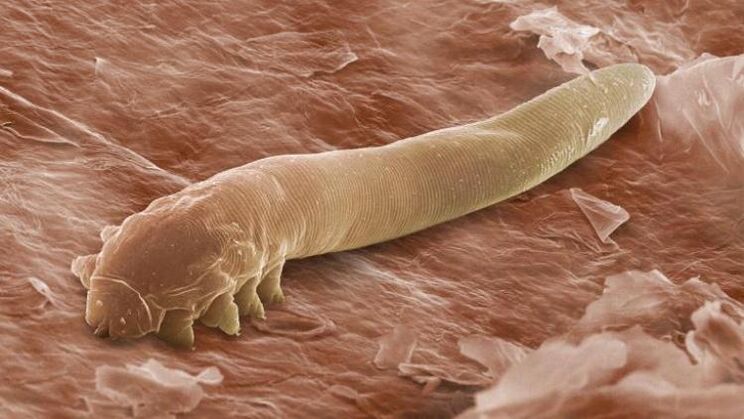
Often, when we hear about parasites, we certainly imagine helminths, but in fact their numbers are huge today.
Many of them can exist in the upper layer of the epithelium and in the subcutaneous fat, remaining invisible to the carrier.
Subcutaneous worms can enter the human body: through contact with an infected person; from blood -sucking insects that carry parasitic larvae from animals.
The main feature of such invasion is the difficulty of recognizing the pathology, because initially the infection can disguise itself as another somatic disease.
The main signs of the presence of this type of parasite in the body are severe weakness, decreased performance, and a constant desire to scratch the skin. When these symptoms appear, it is advisable to consult a specialist: therapist, dermatologist, allergist, infectious disease specialist. Working with doctors and the diagnostic methods used by them in their work helps to recognize the presence of subcutaneous invasion in the body in time.
Types of helminths
There are some subcutaneous worms that can leave a lot of problems with its appearance. It is possible to detect their presence if you pay attention to specific symptoms. With timely diagnosis of the disease, getting rid of unwanted guests will be much easier.
To get an idea of how to quickly recognize their presence, we suggest that you familiarize yourself with the most popular representatives:
Filariasis
This type of helminthiasis is found exclusively in the tropics. Therefore, while traveling, be as careful as possible, it will not be difficult to pick it up.
Pathogens are a great danger, because the incubation period can reach from 5 to 7 years, while they are actively reproducing. They show no signs of their presence, continuing for years to absorb nutrients and vitamins in the body.
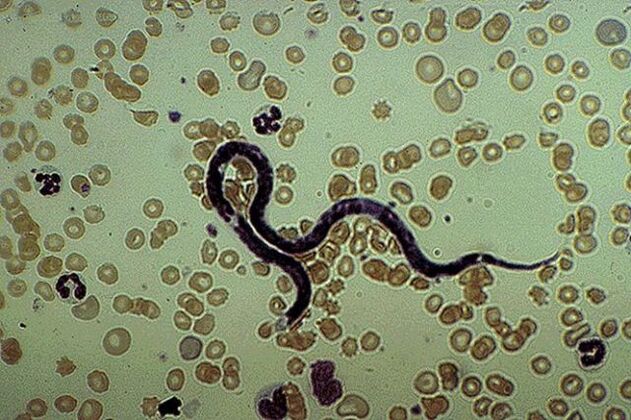
Dracunculiasis
Parasitosis can overwhelm future carriers in helminth -infected water. It is impossible to determine the presence of these parasitic larvae in the water with the naked eye, moreover, neither devices nor special analysis will be able to determine. The danger lies in the fact that the inconspicuous larvae can reach one meter in their mature state. As a rule, infection with dracunculiasis leads to death.
It should be understood that the death was due to the fact that the meter-long helminth occupies a large part of the stomach and easily penetrates the lungs, thus restricting access to oxygen supply. But, as a rule, pathogens are located in the lower part of the legs, so cases of death are relatively rare in modern medicine.
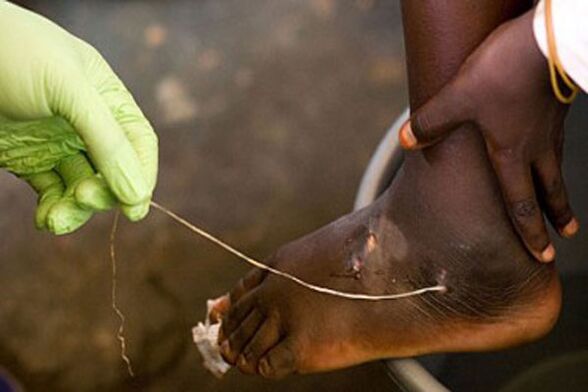
Scabies
This type of disease is the most popular. It would not be an exaggeration that, perhaps, every second inhabitant of the planet has faced this unpleasant disease. The main symptom of this disease is persistent itching of the skin.
If you look closely, you can determine exactly where the worms are, at the place of their localization, you can see significant redness and irritation of the skin. In addition to severe itching, no more unpleasant symptoms were observed in the infected person.
On a note.Transmission is done from a sick person to a healthy one, through physical contact, as well as when using the same thing.
Diagnosis is almost impossible in the absence of special equipment, as mentioned earlier, only the place of accumulation of their mass can be determined. The cause of irritation is explained by the fact that parasitic mites enter the bottom of the epithelium by interfering with the upper layer of the epithelium, thus leaving a significant effect.

demodicosis
Pathogens prefer the sebaceous glands as habitat. Their appearance is accompanied by purulent formation on the face, which is very easily confused with acne. The more intense the parasite grows, the more noticeable it is on the face. In addition to abscesses, it has to be said about another symptom that may seem more unpleasant - loss of eyelashes.
Attention.Diagnosing this parasite is relatively easy compared to other species. An experienced doctor will not prescribe special tests to confirm the presence of helminthiasis, enough for him to conduct only a visual examination of the patient. The fact that the treatment is stretched for several years is also unpleasant. Getting rid of the disease is quite difficult, so even with continuous treatment, it can take more than a year.
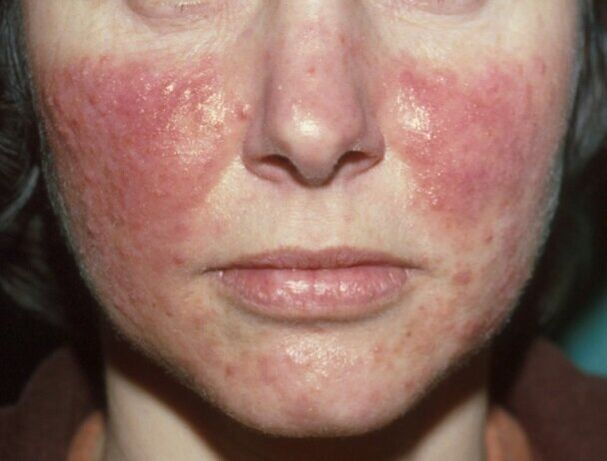
dirofilariasis
These parasites are transmitted to humans through physical contact with infected animals, usually carried by our pets. Ringworms enter the human body quickly, one of the carriers can be a mosquito.
To see this quite easily, the bite becomes dense, inflammation and itching appear. Parasites settle in the body and begin an active life. The most important symptom that will allow you to quickly establish an accurate diagnosis is a feeling of turmoil.
This is due to the fact that adults can move freely. Cases have been recorded when an infected person sees helminths under the skin, and it can also come out through the mucous membranes of the eyes.

Strongyloidiasis
The larvae of this parasite easily penetrate the epidermis, for this it is enough to walk on the ground barefoot.
In addition to severe itching, redness, and significant inflammation, the skin of the infected person is covered with red blisters.
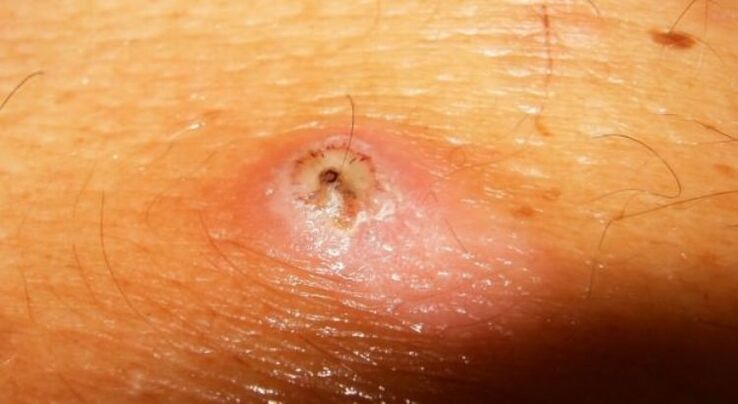
Schistosomiasis
Pathogens are found in Africa and Asia, living exclusively in freshwater. Easily penetrates into the human body. It prefers to be in human skin or in the genitourinary system. Throughout its life, it releases products that are toxic to humans. Toxins seriously irritate the body and cause severe poisoning.
The appearance of this or that parasite is accompanied by certain symptoms, so an experienced doctor will usually diagnose it even before receiving the results of a full medical examination. The survey aims not only to confirm its presence, but also to determine its exact location, as well as an estimate of the number of individuals.

symptoms
What symptoms appear depends on the parasite the person is infected with. There are significant differences, but most of the symptoms are typical for subcutaneous worms. Let's highlight the main symptoms:
- Skin lesions. It can manifest in the form of severe rash, redness, acne, severe itching, in some cases visible worm effects.
- General lethargy. Not only can toxic wastes affect the general condition of the patient, it should be understood that worms consume nutrients from the carrier body, while the carrier body does not receive useful substances. In this case, the weakness increases, a person quickly tired, fever and insomnia can be observed.
- Often, worms penetrate other vital organs, thereby interfering with their work.
- Among subcutaneous helminths, individuals are quite frequently found, the movement of which is well felt by the carrier.
Filariasis
The main symptoms, which may last for the first few years, include:
- urticaria, with the appearance of extensive red spots;
- severe itching;
- temperature rise;
- a state of fever.
After a certain time, the main symptoms are replaced by more serious manifestations, such as:
- eczema, warts, ulcers;
- sleep disorders (increased drowsiness, insomnia);
- persistent migraines;
- subcutaneous nodes;
- some individuals become noticeable when examining a patient’s eyes.
For your information.Such conditions require serious medical intervention, because the prolonged presence of pathogens can lead to loss of vision, tumor development.
Scabies
Accompanied by the following symptoms:
- appearance of rash and redness;
- bubbles may appear in the affected area;
- when applying iodine to the affected skin area, the worm pathway becomes noticeable;
- persistent itching;
- severe skin exfoliation.
Schistosomiasis
Accompanied by the following symptoms:
- rash;
- persistent itching;
- increased sweating, especially at night;
- hyperthermia;
- liver size increases.
dirofilariasis
Accompanied by the following symptoms:
- allergic reactions of the body;
- temperature rise;
- severe fatigue, weakness;
- nausea.
demodicosis
Accompanied by the following symptoms:
- severe acne;
- eyelash loss.
Dracunculiasis
Accompanied by the following symptoms:
- there is inflammation of the joints of the lower legs;
- gangrene;
- blood poisoning.
The emergence of such diseases poses a great threat to human life and health. Many pathogens are carefully hidden for several years after infection, but then their size increases significantly and the manifestations under the skin become noticeable.
The location of subcutaneous worms can be not only in the upper layers of the epithelium and sebaceous glands, it is even more dangerous when helminths move freely through the body, because vital organs can be affected.

Treatment
To date, there are many effective recommendations for the treatment of the disease. It is important to understand that the doctor should prescribe treatment, after receiving the necessary results from a complete medical examination of the patient. In some cases, complications and the appearance of side diseases caused by helminths are observed.
important.As a treatment, complex drug therapy can be prescribed, but you should be aware that most drugs are highly toxic, so you may see a significant deterioration in the condition caused by the treatment.
Often, surgical intervention is required to remove the subcutaneous helminth. Often, hydrochloric acid and sulfuric soap are used for scabies.
Treatment for subcutaneous worms can cause a lot of problems, spending a lot of time and money. Therefore, it is easier to prevent infection, for this you only need to adhere to the rules of personal hygiene. It is recommended not to have physical contact with an infected person.
